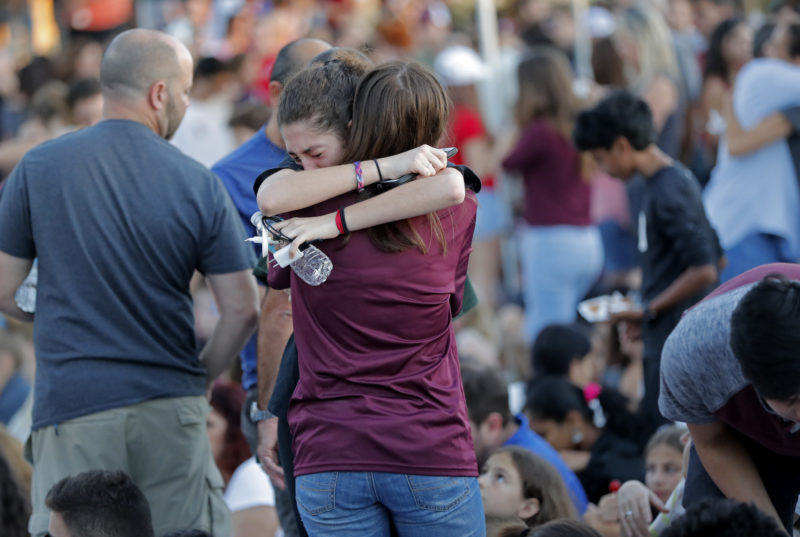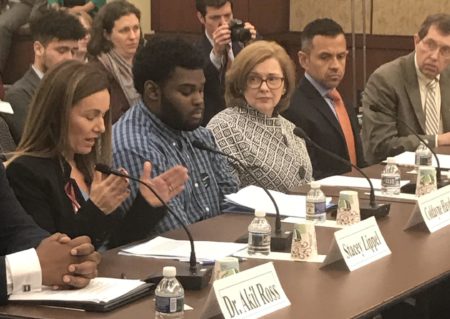 People hug one another before the start of a candlelight vigil for the victims of the Wednesday shooting at Marjory Stoneman Douglas High School, in Parkland, Fla., Thursday, Feb. 15, 2018. (AP Photo/Gerald Herbert)
People hug one another before the start of a candlelight vigil for the victims of the Wednesday shooting at Marjory Stoneman Douglas High School, in Parkland, Fla., Thursday, Feb. 15, 2018. (AP Photo/Gerald Herbert)
Stacey Lippel is a language arts teacher at Marjory Stoneman Douglas High School in Parkland, Fla., where on Feb. 14 a gunman killed 17 students and educators and injured many others. Lippel saved students' lives by pulling them to safety in her classroom and locking the door.
On Tuesday, March 20, Lippel appeared on Capitol Hill to testify before members of Congress. Here are her full remarks:
----------------------
Ladies and gentlemen of the committee, thank you for giving me the time to speak with you today.
On Feb. 14, I spent the day at school like any other day in room 1255 on the third floor of the 1200 building, also known as the Freshman Building, at Marjory Stoneman Douglas High School. It was Valentine’s Day, and the kids were happy and excited as they walked through the halls with their oversized stuffed animals, oversized balloons and oversized energy level. It was fourth period, and I just taught my creative writing class how to write the perfect love letter. They were animated and silly.
Meadow Pollack wrote a letter to her longtime boyfriend. She told me they were together for four years.
Joaquin Oliver resisted this assignment because he already got his girlfriend plenty of things, but I told him a handwritten note would go very far. He proceeded to write love notes on cut-out hearts and taped them to his shirt. My students told me that he did write an actual love letter but put it in his backpack.
Then, everything changed.
At about 2:20, we heard a popping sound that sounded like a computer cart fell over. The class was loud, so the sound was muted. Approximately two minutes later, the fire alarm sounded signaling that we should all evacuate the building. It was unusual because we had already had a drill that morning, but I knew that the culinary classes were cooking with oil, so evacuating was nothing I would have even hesitated doing. So many scenarios popped into my head at that moment... fire in culinary, or maybe that sound was firecrackers and there is a fire. I never, ever thought that this was a result of gunshots because the context wouldn’t have made any sense.
We live in Parkland.
Nothing bad ever happens in Parkland.
I shouted above the alarm to my students that I would be taking attendance at our usual spot outside, grabbed my emergency folder and phone, then waited for the last student to exit before I closed and locked my door behind me. I walked about 2 feet from my door when I heard the gunshots down in the stairwell. The stairwell is about 20 feet away from my classroom. All of the students who were in the stairwell started screaming and running back toward me and the other classrooms. I quickly turned around, unlocked my door and then very quickly ensured that the lock was back in a locked position so that when I shut the door, it would already be locked from the outside. (I don’t know how else to describe this action, but it’s very important because it truly saved my life and my students’ lives.)
Shots were firing and students were pouring into my class: kids who were mine, kids who I had never seen before. I held my door open and pulled kids in as I watched the scene unfold before my eyes. I saw the shooter emerge from the stairwell and stand very firmly at the front of the hall, about 20 feet from me.
 Stacey Lippel (left) testifies at a congressional hearing on Tuesday, March 20.
Stacey Lippel (left) testifies at a congressional hearing on Tuesday, March 20.
He was constantly shooting as he sprayed his rifle back and forth. I don’t know how he didn’t hit more kids with all of the bullets flying in the hallway.
It was foggy with smoke, but I kept my eye on the shooter.
He had on a helmet, gas mask and what I thought was a bulletproof vest that held ammunition. All I know is that he looked like a MAN with a very menacing weapon in his hand. I remember thinking, “Is this real? What is going on here? Why is this man shooting at us?” But I never broke from my task at hand: to get as many kids into my room as possible and get that door shut. I was in autopilot mode.
I don’t remember screaming. I definitely wasn’t crying. I just knew that saving my students and myself was very important.
I don’t know when I decided that now was the time to close my door, but I did. I shouted at Mr. Scott Beigel to close his door because his classroom was right next to mine and he was ushering students into his room just as I was. I grabbed the door handle with both hands because I wanted to make sure I pulled it tight. It was then that I was grazed by a bullet. I remember feeling a little sting, but soon forgot it. As I was shutting my door, two of my students wanted to get in as they were still in the hall.
Understand that even though there were still kids running in the hall, I had to make a decision to shut my door or risk getting shot and putting the students in my room in danger. I don’t remember reopening the door. They told me I did. I opened it a crack, Mr. Beigel shoved them in, then I pulled my door closed and hung onto the handle for a few more seconds to ensure it was really, really closed (another action I don’t remember, but my students told me I did this).
I jumped over to the blind spot in my room where I trained my students to go when we had a code red. I threw myself on top of my students and held on to as many as I could sink my nails into. Seconds later, I heard a barrage of shots in Mr. Beigel’s room, then immediately after that, the shooter fired about four or five times right into my classroom through the glass panel in the door, through the broken glass. I remember stretching my neck to see if he was going to reach in and grab the door handle. I don’t know why he didn’t. He could have easily entered the classroom and shot us all but he didn’t. He continued to fire shots down the hallway. I kept looking at the clock and thinking, “This is definitely not a drill. School should be over soon.” These were the strange and random thoughts we all had, because even though we were living this nightmare, it just seemed impossible that this was happening.
I kept staring at the shattered glass on the floor as well as the bullet casings. We all heard a boy screaming in the hallway, “HELP! OPEN THE DOOR! HELP! LET ME IN!!!” But we couldn’t open the door. The shooter could still be on the floor. If I opened the door, I would put us all at risk. So we cringed every time we heard the screaming. Students were texting their loved ones. I texted a coworker who was on the other side of the school that there was a shooter in my building. My son was in her class. My daughter was in a classroom close to the other side of the school as well. I don’t remember texting my husband. I don’t remember answering texts from concerned family and friends. I
deleted all of my texts that night because it made me sick to my stomach to look back at them. I spent the next hour making eye contact with my students, holding on to them and mouthing that everything was going to be OK.
 Olivier Douliery/Abaca Press(Sipa via AP Images)
Olivier Douliery/Abaca Press(Sipa via AP Images)
When the SWAT team arrived, I still didn’t get up to open the door. What if it’s the shooter? They barged in, pointed their guns at us and ordered us to put our hands up in the air just in case the shooter was among us. One of the men pointed at me and asked, “Teacher?” I said “Yes,” and he asked me to make sure my students didn’t look down as we left the classroom. I stood up and immediately saw the body of Scott Beigel on the ground. I couldn’t process that he was dead until a student looked at him
and screamed. I went into teacher mode and ordered her to look up. We stepped out of the classroom and saw carnage everywhere. There were bullet casings, smoke, shattered glass, blood and bodies throughout the hallway.
It was a war zone.
I still couldn’t process what I was seeing.
We live in Parkland.
Nothing bad ever happens in Parkland.
Students screamed and cried as they looked down and saw their classmates dead on the ground. I grabbed them and pushed them down the stairs and finally out of the building. Two of my beautiful students, Meadow and Joaquin, who were finishing up their senior year on a high note, were brutally murdered. My heart breaks for their families and aches for the loss I feel. I knew them both since they were sophomores.
I do not know how I wasn’t killed. I should have been killed. I am thankful that I reacted the way I did because my students needed me to be there for them, but they are all scarred. I have 219 students on my current roster. Since Feb. 14, an average of 10 percent of my students are absent because they aren’t coping well with their experiences.
They don’t feel safe in school.
I was in the trenches.
I was shot at.
I saw the shooter and what he was capable of doing. I don’t know how he got on campus, and why he chose the 1200 building.
In closing, I would like to thank the committee for inviting me here to share my story and do all that I can to make sure that this never happens again.
I look forward to responding to your questions.






